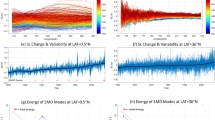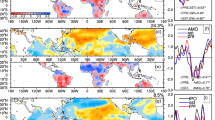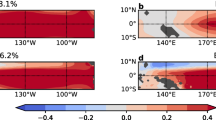Abstract
This study proposes a new more precise and detailed method to examine the performance of IPCC AR4 models in simulation of nonlinear variability of global ocean heat content (OHC) on the annual time scale during 1950–1999. The method is based on the intercomparison of modulated annual cycle (MAC) of OHC and its instantaneous frequency (IF), derived by Empirical Mode Decomposition and Hilbert-Huang Transformation. In addition to indicate the general agreement in gross features globally between models and observation, our results point out the problems both in observation and in modeling. In the well observed Northern Hemisphere, models exhibit extremely good skills to capture nonlinear annual variability of OHC. The simulated MACs are highly correlated with observations (>0.95) and the IF of MACs varies coherently with each other. However, in sparsely observed Southern Hemisphere (SH), even though the simulated MACs highly correlate with observations, the IF shows significant difference. This comparisons show that the models exhibit coherent variability of IF of MACs in SH with each other, but not with observations, revealing the problems in the objective analyzed dataset using sparse observations. In the well observed tropic region, the models lack the coherence with the observations, indicating inadequate physics of the models in the tropical area. These results illustrate that the proposed method can be used routinely to identify problems in both models and in observation of the global ocean as a critical component of global climate change.
















Similar content being viewed by others
References
Antonov JI, Levitus S, Boyer TP (2004) Climatological annual cycle of ocean heat content. Geophys Res Lett 31(4):L04304
Barnett TP, Pierce DW, Schnur R (2001) Detection of anthropogenic climate change in the world’s oceans. Science 292:270–274
Bell TL, Kundu PK (2000) Dependence of satellite sampling error on monthly averaged rain rates: comparison of simple models and recent studies. J Clim 13:449–462
Chen XY, Wu ZH, Huang NE (2010) The time-dependent intrinsic correlation based on the empirical mode decomposition. Adv Adap Data Anal 2:233–265
Fedorov AV, Philander SG (2000) Is El Nino changing? Science 288:1997–2002
Gleckler P, Sperber KR, AchutaRao K (2006) Annual cycle of global ocean heat content: observed and simulated. J Geophys Res 111:C06008. doi:10.1029/2005JC003223
Gleckler P, Taylor K, Doutriaux C (2008) Performance metrics for climate models. J Geophys Res 113:D06104. doi:10.1029/2007JD008972
Gregory JM, Banks HT, Stott PA, Lowe JA, Palmer MD (2004) Simulated and observed decadal variability in ocean heat content. Geophys Res Lett 31:L15312. doi:10.1029/2004GL020258
Gu D, Philander SG, McPhaden MJ (1997) The seasonal cycle and its modulation in the eastern tropical Pacific Ocean. J Phys Oceanogr 27:2209–2218
Hansen J, Nazarenko L, Ruedy R, Sato M, Willis J, Del Genio A, Koch D, Lacis A, Lo K, Menon S (2005) Earth’s energy imbalance: confirmation and implications. Science 308:1431
Hsu CP, Wallace JM (1976) The global distribution of the annual and semiannual cycles in precipitation. Mon Weather Rev 104:1093–1101
Huang NE, Wu Z (2008) A review on Hilbert-Huang transform: method and its applications to geophysical studies. Rev Geophys 46:RG2006
Huang N, Shen Z, Long S, Wu M, Shih H, Zheng Q, Yen N, Tung C, Liu H (1998) The empirical mode decomposition and the Hilbert spectrum for nonlinear and non-stationary time series analysis. Proc R Soc Lond 454:903–995
Huang NE, Wu Z, Long SR, Arnold KC, Chen X, Blank K (2009) On instantaneous frequency. Adv Adap Data Anal 1:177–229
Ingleby B, Huddleston M (2007) Quality control of ocean temperature and salinity profiles—historical and real-time data. J Mar Sys 65:158–175
IPCC (2007) Climate change 2007: the physical science basis. Contribution of Working Group I to the Fourth Assessment Report of the Intergovernmental Panel on Climate Change. In: Solomon S, Qin D, Manning M, Chen Z, Marquis M, Averyt KB, Tignor M, Miller HL (eds) Cambridge University Press, United Kingdom, p 996
Ishii M, Kimoto M, Sakamoto K, Iwasaki S-I (2006) Steric sea level changes estimated from historical ocean subsurface temperature and salinity analyses. J Oceanogr 62:155–170
Kiktev D, Caesar J, Alexander LV, Shiogama H, Collier M (2007) Comparison of observed and multimodeled trends in annual extremes of temperature and precipitation. Geophys Res Lett 34:L10702
Kirtman BP, Fan Y, Schneider EK (2002) The COLA global coupled and anomaly coupled ocean–atmosphere GCM. J Clim 15:2301–2320
Knutti R, Abramowitz G, Collins M, Eyring V, Gleckler PJ, Hewitson B, Mearns L (2010) Good practice guidance paper on assessing and combining multi model climate projections. In: Stocker TF, Qin D, Plattner G-K, Tignor M, Midgley PM (eds) Meeting Report of the Intergovernmental Panel on Climate Change Expert Meeting on Assessing and Combining Multi Model Climate Projections. IPCC Working Group I Technical Support Unit, University of Bern, Bern
Levitus S, Boyer TP, Conkright ME, O’Brien T, Antonov J, Stephens C, Stathoplos L, Johnson D, Gelfeld R (1998) World Ocean Database 1998, NOAA Atlas NESDIS 18. NOAA, Silver Spring
Levitus S, Antonov JI, Wang J, Delworth TL, Dixon KW, Broccoli AJ (2001) Anthropogenic warming of Earth’s climate system. Science 292:267–270. doi:10.1126/science.1058154
Levitus S, Antonov JI, Bouer TP, Locarnini RA, Garcia HE, Mishonov AV (2009) Global ocean heat content 1955–2008 in light of recently revealed instrumentation problems. Geophys Res Lett 36:L07608. doi:10.1029/2008GL037155
Locarnini RA, Mishonov AV, Antonov JI, Boyer TP, Garcia HE, Baranova OK, Zweng MM, Johnson DR (2010) World Ocean Atlas 2009, volume 1: temperature. In: Levitus S (ed) NOAA Atlas NESDIS 68. U.S. Government Printing Office, Washington, D.C., p 184
Lyman JM, Good SA, Gouretski VV, Ishii M, Johnson GC, Palmer MD, Smith DM, Willis JK (2010) Robust warming of the global upper ocean. Nature 465:334–337. doi:10.1038/nature09043
Meehl GA, Boer GJ, Covey C, Latif M, Stouffer RJ (2000) The coupled model intercomparison project (CMIP). Bull Amer Meteor Soc 81:313–318
Meehl GA, Covey C, McAvaney B, Latif M, Stouffer RJ (2005) Overview of the coupled model intercomparison project. Bull Amer Meteor Soc 86:89–93
Pezzulli S, Stephenson DB, Hannachi A (2005) The variability of seasonality. J Clim 18:71–88
Pincus R, Batstone CP, Hofmann RJP, Taylor KE, Glecker PJ (2008) Evaluating the present day simulation of clouds, precipitation, and radiation in climate models. J Geophys Res 113:D14209. doi:10.1029/2007JD009334
Reichert BK, Schnur R, Bengtsson L (2002) Global ocean warming tied to anthropogenic forcing. Geophys Res Lett 29:1525. doi:10.1029/2001GL013954
Reichler T, Kim J (2008) How well do coupled models simulate today’s climate? Bull Amer Meteor Soc 89(3):303–311
Sun S, Hansen JE (2003) Climate simulations for 1951–2050 with a coupled atmosphere-ocean model. J Clim 16:2807–2826
Talley LD, Pickard GL, Emery WJ, Swift JH (2011) Descriptive physical oceanography, an introduction. ELSEVIER Press, NY
Wu Z, Huang NE (2009) Ensemble empirical mode decomposition: a noise-assisted data analysis method. Adv Adap Data Anal 1:1–41
Wu Z, Schneider EK, Kirtman BP, Sarachik ES, Huang NE, Tucker CJ (2008) The modulated annual cycle: an alternative reference frame for climate anomalies. Clim Dyn 31:823–841. doi:10.1007/s00382-008-0437-z
Xue Y, Balmaseda MA, Boyer TP, Ferry N, Good SA, Ishikawa I, Kumar A, Rienecker M, Rosati AJ, Yin Y (2012) A comparative analysis of upper ocean heat content variability from an ensemble of operational ocean reanalyses J Clim 25:6905–6929. doi:10.1171/JCLO-D-11-00542.1
Acknowledgments
This works was supported by National Science Foundation of China 41176029 and 41106033, Public science and technology research funds projects of ocean 201105019, and Chinese Polar Research Project CHINARE2012-04-04. ZW and NEH were supported by a grant from Federal Highway Administration, DTFH61-08-00028, and grants from NSC, NSC95-2119-M-008-031-MY3, NSC97-2627-B-008-007, and a grant from NCU 965941.
Author information
Authors and Affiliations
Corresponding author
Electronic supplementary material
Below is the link to the electronic supplementary material.
Rights and permissions
About this article
Cite this article
Chen, X., Zhang, Y., Zhang, M. et al. Intercomparison between observed and simulated variability in global ocean heat content using empirical mode decomposition, part I: modulated annual cycle. Clim Dyn 41, 2797–2815 (2013). https://doi.org/10.1007/s00382-012-1554-2
Received:
Accepted:
Published:
Issue Date:
DOI: https://doi.org/10.1007/s00382-012-1554-2




